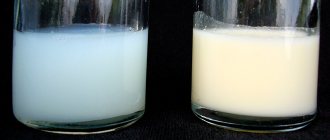Glycine during breastfeeding solves problems of nervous system disorders in both mother and child. The amino acid normalizes sleep, relieves excessive nervous excitement, prevents the appearance of apathy, chronic fatigue, and weakness. Take Glycine 1 tablet 2-3 times a day, one-time doses will not give an effect, a course of 7 to 30 days is needed.
Alternative drugs are Glycine forte, Glycine-Bio and others, their composition is enriched with a vitamin complex. You can use valerian, but only after consulting your doctor.
Why you may need Glycine while breastfeeding
Glycine during breastfeeding may be required if it is necessary to stabilize the psycho-emotional background of the mother and cope with impending postpartum depression. This drug:
- lifts your mood and reduces the intensity of its swings;
- increases the performance of the brain, improves its mental activity;
- accelerates the process of falling asleep, stabilizes sleep;
- restores mental state, removes neuroses;
- reduces aggressiveness, reduces the likelihood of hysteria.
Glycine has a dilating effect on blood vessels.
When breastfeeding, Glycine is allowed to be taken because it is a natural amino acid - natural for the body, and does not affect the quantity and quality of milk. The drug will help:
- lower blood pressure (if it periodically increases in the mother);
- improve a woman’s performance, increase her activity;
- stimulate memory, concentration;
- reduce the symptoms of vegetative-vascular dystonia;
- restore normal, full sleep.
Doctors warn that during lactation you should not take medications on your own, and Glycine falls into this category - it affects each woman individually and can have a negative impact on the breastfeeding process.
We recommend reading about how to take Glycine during pregnancy. From the article you will learn why Glycine is needed during pregnancy, how it affects the fetus and the mother, instructions for use. And here is more information about why you take Glycine before bed.
Composition and characteristics of the drug
The main active ingredient of the drug is an essential amino acid, which a priori has a beneficial effect on the human body. It is able to influence metabolic processes in the brain, which leads to the saturation of cells with oxygen, normalization of the condition of nerve cells and eliminates the appearance of restless, nervous conditions.
The essential amino acid is contained in Glycine in small concentrations, therefore it has a gentle, gentle effect on the body of a nursing woman. As soon as it enters the blood, the decay process begins and as a result water and carbon dioxide are formed - the amino acid does not linger in the body and does not cause dependence or addiction.
A single dose of a tablet does not give the promised result; Glycine must be taken in courses.
Does it affect the child?
If the instructions for use of Glycine tablets are strictly followed by the nursing mother, then a minimum amount of the essential amino acid enters the child’s body. And in this case, there will be a positive effect on the baby:
- heart rate normalizes and stabilizes;
- signs of increased excitability of the newborn disappear;
- muscle tone is normalized, the intensity of manifestations of hypertonicity decreases.
Pediatricians even prescribe Glycine in a course as part of therapy for a baby’s poor sleep and frequent whims.
What is glycine and how does it affect the body?
Scientists have determined that this substance belongs to the class of amino acids. It consists of protein compounds. Any person receives a small dose of glycine by eating protein foods. The human body does not consider glycine a foreign compound, so drug rejection usually does not occur.
Medicines produced by pharmaceutical companies contain glycine in concentrated form. When taking the medicine, it has a beneficial effect on the central nervous system.
The effect on the patient of this medication is as follows:
- In patients, metabolic processes normalize.
- The nervous state is eliminated and fatigue is relieved.
- Under the influence of glycine, the patient calms down. The excitement caused by stress disappears.
- Stimulation of nerve cells in the brain occurs.
- The patient's memory improves. He concentrates his attention better on a problem.
- The medicine eliminates insomnia and stabilizes sleep patterns.
- Under the influence of glycine, the risk of developing autonomic disorders in the vascular system sharply decreases.
The substance accelerates metabolic processes in the body, especially in the brain. But you should know that with long-term use of glycine, early cell aging can occur, which will lead to the appearance of sclerotic phenomena in the brain. This will worsen a person's memory.
During lactation, a woman is prescribed a course lasting 2-4 (sometimes more) weeks. In such cases, glycine cannot cause the processes described above. Usually the medication is taken in the daytime 3 times a day. The tablet should be placed under the tongue and held until it is completely absorbed. If the mother’s nervousness does not go away after the course of therapy, then she should take a break from taking the medication for about 7 days, and then repeat the treatment process.
Since the concentration of amino acid in the tablets is minimal, the medication has a mild effect on the patient. Once in the blood, the amino acid is destroyed. This produces carbon dioxide and water. These components do not accumulate in the human body, so there is no addiction to the drug. But a one-time dose of glycine does not have the desired effect on the patient. Therefore, the doctor prescribes a person a certain course of therapy with this drug.
Signs indicating a lack of glycine during breastfeeding
There are no pronounced symptoms that clearly indicate a lack of glycine during breastfeeding, but this can be suspected if:
- obvious exhaustion at the psycho-emotional level;
- apathy, decreased appetite;
- the constant presence of fatigue and weakness against the background of habitual physical activity;
- sleep disturbance, difficulty falling asleep.
If there is not enough amino acid in the body, then the woman’s skin condition may worsen, and laboratory tests will reveal a decrease in hemoglobin levels.
Is it always possible to drink Glycine while breastfeeding?
Despite its safety and undoubted benefits, Glycine cannot always be taken while breastfeeding; there are a number of contraindications to such therapeutic courses:
- allergy to the main active ingredient;
- refusal of the newborn to breastfeed;
- “lethargic”, sleepy state of the baby;
- child's sleep disturbance;
- increased excitability in the baby, constant crying.
If the listed symptoms are present, then the mother should abandon Glycine and, together with the doctor, select another sedative.
Watch this video about the benefits of Glycine, including during breastfeeding:
Is it possible to take this drug during breastfeeding?
Glycine is one of the drugs that can be used by women while breastfeeding without worrying about the health of the mother and her baby. This sedative is considered one of the safest; sometimes it is even given to children for sleep disturbances and restless behavior.
Composition of the drug
Reference. Glycine is made exclusively from plant materials, the main active ingredient is aminoacetic acid. The composition also includes excipients magnesium stearate and methylcellulose - 1 mg per 100 mg of glycine.
Aminoacetic acid is one of the most important amino acids in the human body, as it is necessary for the production of growth hormone and the synthesis of various acids, including nucleic acids.
Due to the action of this amino acid:
- metabolic processes of the brain are stabilized;
- nerve impulses are regulated;
- oxygen supply to cells improves;
- excessive stimulation of the central nervous system is relieved.
But the content of the active substance in glycine is small, so the drug has a rather gentle effect on the body. In addition, in the blood, aminoacetic acid is broken down into water and carbon dioxide, which do not accumulate in the body.
The dosage of the active substance depends on the type of drug; it can be 100, 250, 300, 500 and 600 mg.
Action
When taking glycine, the following positive changes are noted in the body of a nursing woman:
- upset states, anxiety, psycho-emotional arousal decrease;
- stress resistance increases;
- mental performance improves;
- manifestations of conflict and aggression are reduced;
- vegetative-vascular disorders are weakened;
- sleep is normalized and falling asleep is easier;
- mood improves;
- the toxic effect of drugs that depress the central nervous system is reduced;
- metabolic processes are normalized;
- cravings for sweets are reduced and weight is normalized.
Rules for using Glycine for a nursing mother: instructions, dosage in tablets
Instructions for use: Glycine for a nursing mother is taken 1 tablet 2-3 times a day. It is placed under the tongue and remains there until completely dissolved. There is no need to drink/swallow the drug - the amino acid will be absorbed in the digestive tract and will not have any positive effect on the nervous system. Doctors allow you to first crush the tablet into powder and absorb it into the oral mucosa in this form.
A single dose of Glycine tablet will not have any effect, so you need to take this drug in a course. The duration of therapy varies from 7 days to 1 month, the doctor will tell you more precisely. If one course is not enough to normalize the mother’s condition, then a second course can be prescribed 30 days after the end of the previous one.
Signs of allergies in mothers
The mother may develop an allergy to Glycine and it will be characterized by the following symptoms:
- itching of the skin;
- small rashes on the dermis;
- shortness of breath, difficulty breathing;
- nasal congestion.
Itchy skin
In some cases, a woman’s allergy to an essential amino acid develops so rapidly that anaphylactic shock and Quincke’s edema are diagnosed.
Other complications of breastfeeding
When breastfeeding, Glycine can cause a decrease in blood pressure, and this is fraught with dizziness, blurred vision, loss of strength and headaches.
During drug therapy, a woman should periodically monitor her blood pressure readings, and if they steadily decrease, then the use should be interrupted and consult a doctor about replacing the sedative.
In rare cases, complications after taking Glycine while breastfeeding may cause a woman to experience nausea, which in isolated cases ends in vomiting.
Alternative drugs
Alternative drugs include those in which the main active ingredient is the same essential amino acid - Glycised, Glycine-Bio, Glycine-Vis. The most popular is Glycine forte, the composition of which is enriched with vitamins:
- B1 – improves brain activity, activates the work of nerve cells;
- B12 – acts as an accelerator of regenerative processes in the central nervous system;
- B6 – necessary for maximum absorption of vitamin B12.
A nursing woman should take into account that alternative drugs may cause allergies and have individual contraindications for use due to the presence of additional components in the composition.
A nursing mother can also take medications with valerian - they calm her down, relieve nervous excitement, and normalize sleep. But valerian has many contraindications for use; it can negatively affect the baby’s condition and inhibit its development. Replacement of Glycine with alternative drugs is possible only after agreement with the attending physician.
Recommendations for use while breastfeeding
Any medicine should not be taken uncontrolled, this is especially important for a nursing woman. When determining the dosage and regimen of taking the drug, consultation with a doctor who monitors the condition of the mother and newborn is required. Violating the scheme recommended by a specialist is strictly prohibited.
During treatment with glycine, it is imperative to monitor the condition of the mother and child. If an allergic reaction occurs, you should stop taking glycine.
Typically, a nursing mother is prescribed glycine according to the following regimen: 1 tablet with a dosage of 100 mg 2-3 times a day. The tablet must be placed under the tongue and dissolved slowly. The standard course of treatment is from 2 to 4 weeks. If necessary and if there are no side effects for mother and baby, the course is repeated.
It is worth keeping in mind that a single dose of the drug is not enough to obtain the desired effect; it should be taken in a course.
How else can you get glycine safely during lactation?
If the lack of glycine in a woman’s body does not manifest itself as severe symptoms, then during lactation it can be obtained from certain foods:
- jellied meat, fish aspic, “strong” broths with beef bones;
- walnuts, peanuts;
- sesame seeds;
- fennel;
- pumpkin seeds.
During lactation, many foods are undesirable for consumption, so you need to consult a nutritionist about creating a menu.
We recommend reading about why you take Glycine complex magnesium B6. From the article you will learn about the instructions for use of Glycine complex magnesium B6 for children and adults, contraindications, and analogues of the drug. And here is more information about the rules for using Glycine for infants.
Glycine during breastfeeding, if indicated for use by a doctor, will have a beneficial effect on both the mother and the baby. They will both sleep peacefully, increased excitability will disappear, and the woman will additionally have the prevention of postpartum depression.











